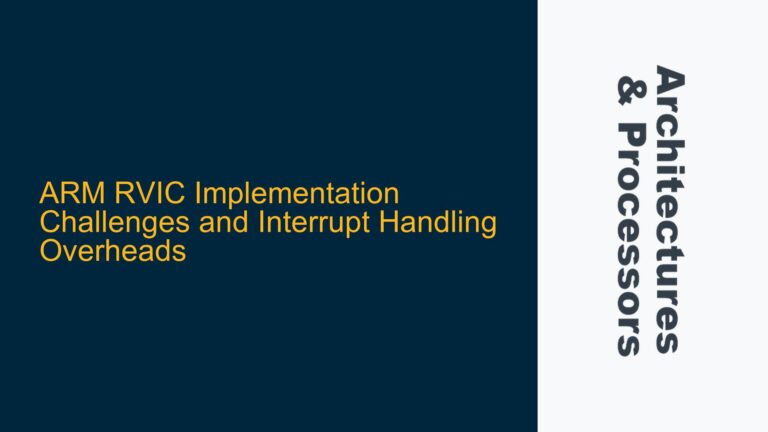PMU Register Removal and Cycle Count Measurement Limitations in FVP Corstone SSE-300
The Fast Models Fixed Virtual Platform (FVP) Corstone SSE-300 is a widely used simulation environment for ARM-based SoC designs. One of the critical challenges faced by developers and verification engineers is the accurate measurement of cycle counts for performance analysis. Historically, the Performance Monitoring Unit (PMU) registers, such as the PMU_CCNTR, were used to measure cycle counts. However, recent updates to the FVP Corstone SSE-300 have removed the "has_pmu" parameter, which was instrumental in enabling PMU functionality. This change has significant implications for performance analysis, particularly for legacy codebases that rely on cycle-accurate measurements.
The removal of the "has_pmu" parameter in version 11.22 of the ARMCortexM55CT component, which is integral to the FVP Corstone SSE-300, was motivated by the need to align the simulation model more closely with the actual hardware configuration. In hardware, the presence of the PMU is determined by the DBGLVL parameter, which is set to 2 by default in the FVP Corstone SSE-300. This means that while the PMU registers still exist in the simulation model, their functionality is limited, and the cycle counts they provide are not accurate. This limitation is further compounded by the fact that FVP models are not cycle-accurate, rendering the cycle count values relatively meaningless for precise performance analysis.
Misalignment Between Simulation Models and Hardware PMU Behavior
The removal of the "has_pmu" parameter and the subsequent reliance on the DBGLVL parameter to determine PMU presence highlight a broader issue: the misalignment between simulation models and actual hardware behavior. In hardware, the PMU is a critical component for performance monitoring, providing detailed insights into cycle counts, cache misses, branch predictions, and other performance metrics. However, in the FVP Corstone SSE-300, the PMU registers are implemented primarily to ensure software compatibility, rather than to provide accurate performance data.
This misalignment is particularly problematic for developers who rely on simulation models to optimize their code for performance. Without accurate cycle counts, it becomes challenging to identify performance bottlenecks, optimize critical code paths, and validate the effectiveness of performance-enhancing techniques. Furthermore, the lack of cycle accuracy in FVP models means that even if the PMU registers were fully functional, the data they provide would not be representative of actual hardware performance.
The limitations of the PMU in the FVP Corstone SSE-300 are further exacerbated by the fact that not all PMU event counters are implemented in the simulation model. This means that while the PMU registers exist and can be accessed by software, many of the counters will return zero values, regardless of the actual performance characteristics of the code being executed. This behavior can lead to misleading results, as developers may interpret the zero values as indicative of optimal performance, when in reality, the simulation model is simply not capturing the relevant performance metrics.
Strategies for Accurate Performance Measurement in Non-Cycle-Accurate Environments
Given the limitations of the FVP Corstone SSE-300 in providing accurate cycle counts, developers and verification engineers must adopt alternative strategies for performance measurement. One approach is to use older versions of the FVP Corstone SSE-300 that still support the "has_pmu" parameter. However, this approach is not without its challenges, as older versions of the simulation model may not be readily available, and using outdated software can introduce compatibility issues with newer toolchains and libraries.
Another strategy is to leverage other performance monitoring tools and techniques that are not reliant on cycle-accurate simulation models. For example, developers can use software-based profiling tools to measure execution time, identify performance bottlenecks, and optimize their code. These tools, while not providing cycle-level accuracy, can still offer valuable insights into the performance characteristics of the code being executed.
In addition to software-based profiling, developers can also use hardware performance counters available on actual ARM-based SoCs to validate the performance of their code. By running the code on real hardware and measuring performance metrics using the PMU, developers can obtain accurate performance data that can be used to guide optimization efforts. This approach, while requiring access to physical hardware, provides the most accurate and reliable performance measurements.
Finally, developers can consider using more advanced simulation environments that offer greater accuracy and fidelity than the FVP Corstone SSE-300. For example, cycle-accurate simulation models, while more computationally intensive, can provide detailed performance data that closely mirrors the behavior of actual hardware. These models can be particularly useful for performance-critical applications where even small improvements in code efficiency can have a significant impact on overall system performance.
In conclusion, while the removal of the "has_pmu" parameter in the FVP Corstone SSE-300 presents challenges for accurate cycle count measurement, developers and verification engineers can adopt a range of strategies to overcome these limitations. By leveraging alternative performance monitoring tools, validating performance on actual hardware, and using more advanced simulation environments, it is possible to obtain accurate and reliable performance data that can guide optimization efforts and ensure the efficient execution of code on ARM-based SoCs.






